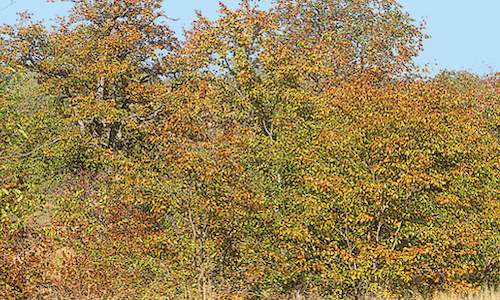It has been predicted that with the rise of climate change, the distribution of mopane trees will change dramatically. ©Tony Swemmer
©Tony Swemmer
The Ndlovu Node of the South African Environmental Observation Network (SAEON) initiated a project to help map the southern and western boundary of this remarkable tree species. The work involved walking long distances through the Kruger National Park and adjacent private nature reserves, and recording the presence of mopanes on a handheld GPS.More than 60 volunteers had responded to SAEON's call for volunteers to work on the project in 2008. Ndlovu Node made use of physically fit volunteers, usually working in pairs, who participated for two or more days (weekdays or weekends) between May 14 and the end of June 2008. All volunteers were accompanied by qualified game guards and were taught the simple skills required.
The Bateleurs, an organisation of volunteer pilots, also assisted with the project by locating suitable areas for the ground-based volunteers to work in. The aerial survey was significant in the accurate collection of data as vast areas of the Kruger or not accessible by road. Once the suitable research sites were identified, samples of the tree leaves and the soil beneath them were taken. These samples were analyzed and recorded in a research proposal that was presented to the National Science Foundation in the USA.

The first Mopane Range Expansion Project in 2008 proved to be such as success, leading to a second year of this project.
The results of the initial research project confirmed that a relationship between the tree and its abundant distribution on the southern boundary of the park exists.
It has been predicted that with the progression of climate change, the distribution of mopane trees will change dramatically.
The project of mapping the distribution of the savannah tree aims to map the occurrence of the species along the southern boundary.
Mopane trees dominate the vegetation in the northern half of the Kruger National Park, and much of the Limpopo Province. As many frustrated tourists know, wildlife is far less common in these areas, and the spread of mopane to the south would have important consequences, not only for large game and the tourists that follow them, but also for other plant and animal species and a range of ecosystem processes. And computer models predict that global climate change may lead to a spread of mopane, as higher temperatures lead to more favourable growing conditions to the south and west of its current distribution.The Ndlovu Node of the South African Environmental Observation Network (SAEON) initiated a project to help map the southern and western boundary of this remarkable tree species. The work involved walking long distances through the Kruger National Park and adjacent private nature reserves, and recording the presence of mopanes on a handheld GPS.More than 60 volunteers had responded to SAEON's call for volunteers to work on the project in 2008. Ndlovu Node made use of physically fit volunteers, usually working in pairs, who participated for two or more days (weekdays or weekends) between May 14 and the end of June 2008. All volunteers were accompanied by qualified game guards and were taught the simple skills required.
The Bateleurs, an organisation of volunteer pilots, also assisted with the project by locating suitable areas for the ground-based volunteers to work in. The aerial survey was significant in the accurate collection of data as vast areas of the Kruger or not accessible by road. Once the suitable research sites were identified, samples of the tree leaves and the soil beneath them were taken. These samples were analyzed and recorded in a research proposal that was presented to the National Science Foundation in the USA.
By Tony Swemmer

 The most diagnostic feature of the Mopane tree is undoubtedly the butterfly-shaped leaves, which are bright green when they emerge but turn ...
The most diagnostic feature of the Mopane tree is undoubtedly the butterfly-shaped leaves, which are bright green when they emerge but turn ...